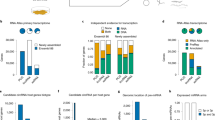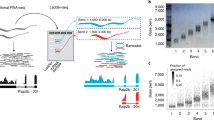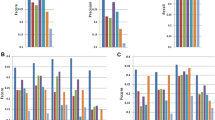Abstract
Massively parallel cDNA sequencing (RNA-Seq) provides an unbiased way to study a transcriptome, including both coding and noncoding genes. Until now, most RNA-Seq studies have depended crucially on existing annotations and thus focused on expression levels and variation in known transcripts. Here, we present Scripture, a method to reconstruct the transcriptome of a mammalian cell using only RNA-Seq reads and the genome sequence. We applied it to mouse embryonic stem cells, neuronal precursor cells and lung fibroblasts to accurately reconstruct the full-length gene structures for most known expressed genes. We identified substantial variation in protein coding genes, including thousands of novel 5′ start sites, 3′ ends and internal coding exons. We then determined the gene structures of more than a thousand large intergenic noncoding RNA (lincRNA) and antisense loci. Our results open the way to direct experimental manipulation of thousands of noncoding RNAs and demonstrate the power of ab initio reconstruction to render a comprehensive picture of mammalian transcriptomes.
This is a preview of subscription content, access via your institution
Access options
Subscribe to this journal
Receive 12 print issues and online access
$209.00 per year
only $17.42 per issue
Buy this article
- Purchase on SpringerLink
- Instant access to full article PDF
Prices may be subject to local taxes which are calculated during checkout





Similar content being viewed by others
Accession codes
Change history
09 July 2010
In the version of this article initially published, the fourth sentence in the methods section “RNA extraction and library preparation” instead of saying a “procedure that combines a random priming step with a shearing step8,9,28 and results in fragments of ~700 bp in size” should have read, “procedure that combines fragmentation of mRNA to a peak size of ~750 nucleotides by heating6 followed by random-primed reverse transcription8.”. The error has been corrected in the HTML and PDF versions of the article.
References
Carninci, P. et al. The transcriptional landscape of the mammalian genome. Science 309, 1559–1563 (2005).
Kapranov, P. et al. RNA maps reveal new RNA classes and a possible function for pervasive transcription. Science 316, 1484–1488 (2007).
Bertone, P. et al. Global identification of human transcribed sequences with genome tiling arrays. Science 306, 2242–2246 (2004).
Guttman, M. et al. Chromatin signature reveals over a thousand highly conserved large non-coding RNAs in mammals. Nature 458, 223–227 (2009).
Khalil, A.M. et al. Many human large intergenic noncoding RNAs associate with chromatin-modifying complexes and affect gene expression. Proc. Natl. Acad. Sci. USA 106, 11667–11672 (2009).
Cloonan, N. et al. Stem cell transcriptome profiling via massive-scale mRNA sequencing. Nat. Methods 5, 613–619 (2008).
Wang, E.T. et al. Alternative isoform regulation in human tissue transcriptomes. Nature 456, 470–476 (2008).
Mortazavi, A., Williams, B.A., McCue, K., Schaeffer, L. & Wold, B. Mapping and quantifying mammalian transcriptomes by RNA-Seq. Nat. Methods 5, 621–628 (2008).
Yassour, M. et al. Ab initio construction of a eukaryotic transcriptome by massively parallel mRNA sequencing. Proc. Natl. Acad. Sci. USA 106, 3264–3269 (2009).
Pan, Q., Shai, O., Lee, L.J., Frey, B.J. & Blencowe, B.J. Deep surveying of alternative splicing complexity in the human transcriptome by high-throughput sequencing. Nat. Genet. 40, 1413–1415 (2008).
Maher, C.A. et al. Transcriptome sequencing to detect gene fusions in cancer. Nature 458, 97–101 (2009).
Birol, I. et al. De novo transcriptome assembly with ABySS. Bioinformatics 25, 2872–2877 (2009).
Trapnell, C., Pachter, L. & Salzberg, S.L. TopHat: discovering splice junctions with RNA-Seq. Bioinformatics 25, 1105–1111 (2009).
Denoeud, F. et al. Annotating genomes with massive-scale RNA sequencing. Genome Biol. 9, R175 (2008).
Pruitt, K.D., Tatusova, T. & Maglott, D.R. NCBI reference sequences (RefSeq): a curated non-redundant sequence database of genomes, transcripts and proteins. Nucleic Acids Res. 35, D61–D65 (2007).
Mikkelsen, T.S. et al. Genome-wide maps of chromatin state in pluripotent and lineage-committed cells. Nature 448, 553–560 (2007).
Lin, M.F., Deoras, A.N., Rasmussen, M.D. & Kellis, M. Performance and scalability of discriminative metrics for comparative gene identification in 12 Drosophila genomes. PLOS Comput. Biol. 4, e1000067 (2008).
Lin, M.F. et al. Revisiting the protein-coding gene catalog of Drosophila melanogaster using 12 fly genomes. Genome Res. 17, 1823–1836 (2007).
Garber, M. et al. Identifying novel constrained elements by exploiting biased substitution patterns. Bioinformatics 25, i54–i62 (2009).
Brown, C.J. et al. A gene from the region of the human X inactivation centre is expressed exclusively from the inactive X chromosome. Nature 349, 38–44 (1991).
Rinn, J.L. et al. Functional demarcation of active and silent chromatin domains in human HOX loci by noncoding RNAs. Cell 129, 1311–1323 (2007).
Willingham, A.T. et al. A strategy for probing the function of noncoding RNAs finds a repressor of NFAT. Science 309, 1570–1573 (2005).
Zhao, J., Sun, B.K., Erwin, J.A., Song, J.J. & Lee, J.T. Polycomb proteins targeted by a short repeat RNA to the mouse X chromosome. Science 322, 750–756 (2008).
Katayama, S. et al. Antisense transcription in the mammalian transcriptome. Science 309, 1564–1566 (2005).
Wu, J. Q. et al. Dynamic transcriptomes during neural differentiation of human embryonic stem cells revealed by short, long, and paired-end sequencing. Proc. Natl. Acad. Sci. USA 107, 5254–5259 (2010).
Ramsköld, D., Wang, E.T., Burge, C.B. & Sandberg, R. An abundance of ubiquitously expressed genes revealed by tissue transcriptome sequence data. PLOS Comput. Biol. 5, e1000598 (2009).
Conti, L. et al. Niche-independent symmetrical self-renewal of a mammalian tissue stem cell. PLoS Biol. 3, e283 (2005).
Berger, M. F. et al. Integrative analysis of the melanoma transcriptome. Genome Res. 20, 413–427 (2010).
Lister, R. et al. Highly integrated single-base resolution maps of the epigenome in Arabidopsis. Cell 133, 523–536 (2008).
Langmead, B., Trapnell, C., Pop, M. & Salzberg, S.L. Ultrafast and memory-efficient alignment of short DNA sequences to the human genome. Genome Biol. 10, R25 (2009).
Ewens, W.J. & Grant, G.R. Statistical Methods in Bioinformatics: An Introduction 2nd edn. (Springer, 2005).
Glaz, J., Naus, J.I. & Wallenstein, S. Scan Statistics (Springer, 2001).
Acknowledgements
We thank M. Wernig (MIT) for providing NPC; M. Lin and M. Kellis (MIT) for CSF code; the Broad Sequencing Platform for sample sequencing; L. Gaffney for assistance with graphics; and C. Burge, J. Merkin, R. Bradley and members of Lander and Regev laboratories—in particular, M. Yassour, T. Mikkelsen and I. Amit—for discussions. A.R. and J.L.R. were supported by the Merkin Family Foundation for Stem Cell Research at the Broad Institute. M. Guttman was supported by a Vertex scholarship. Work was supported by a Burroughs Wellcome Fund Career Award at the Scientific Interface, a US National Institutes of Health PIONEER award, a US National Human Genome Research Institute (NHGRI) R01 grant and the Howard Hughes Medical Institute (A.R.), and NHGRI and the Broad Institute of MIT and Harvard (E.S.L.).
Author information
Authors and Affiliations
Contributions
M. Guttman and M. Garber conceived the project, designed research, implemented Scripture, performed computational analysis and wrote the paper. A.G., C.N. and J.Z.L. oversaw cDNA sequencing, provided molecular biology advice and helped to edit the manuscript. J.D. constructed cDNA libraries, performed validation experiments and helped to edit the manuscript. J.R. implemented components of Scripture and provided computational support and technical advice. X.A., L.F. and M.J.K. constructed cDNA libraries. J.L.R. provided reagents and helped edit the manuscript. E.S.L. designed research direction and wrote the paper. A.R. provided cDNA sequencing guidance, conceived the project, designed research direction and wrote the paper.
Corresponding authors
Ethics declarations
Competing interests
The authors declare no competing financial interests.
Supplementary information
Supplementary Text and Figures
Supplementary Notes 1 and 2, Supplementary Figures 1–7 (PDF 3117 kb)
Supplementary Table 1
Number of novel transcriptional events in ES, MLF and NPC (XLS 10 kb)
Supplementary Table 2
Primer sequences used for validation of novel events (XLS 13 kb)
Supplementary Software
scripture.jar scripture.src.tgz (ZIP 15384 kb)
Supplementary Data
ES.gff.gz ESTranscriptGraphs.tar.gz (ZIP 37695 kb)
Supplementary Data
MLF.gff.gz MLFTranscriptGraphs.tar.gz (ZIP 14834 kb)
Supplementary Data
NPC.gff.gz NPCTranscriptGraphs.tar.gz (ZIP 42407 kb)
Rights and permissions
About this article
Cite this article
Guttman, M., Garber, M., Levin, J. et al. Ab initio reconstruction of cell type–specific transcriptomes in mouse reveals the conserved multi-exonic structure of lincRNAs. Nat Biotechnol 28, 503–510 (2010). https://doi.org/10.1038/nbt.1633
Received:
Accepted:
Published:
Issue Date:
DOI: https://doi.org/10.1038/nbt.1633
This article is cited by
-
Genomic survey of high-throughput RNA-Seq data implicates involvement of long intergenic non-coding RNAs (lincRNAs) in cytoplasmic male-sterility and fertility restoration in pigeon pea
Genes & Genomics (2023)
-
StringFix: an annotation-guided transcriptome assembler improves the recovery of amino acid sequences from RNA-Seq reads
Genes & Genomics (2023)
-
Transcriptome-guided annotation and functional classification of long non-coding RNAs in Arabidopsis thaliana
Scientific Reports (2022)
-
lncRNA–disease association prediction method based on the nearest neighbor matrix completion model
Scientific Reports (2022)
-
Accurate assembly of multi-end RNA-seq data with Scallop2
Nature Computational Science (2022)



